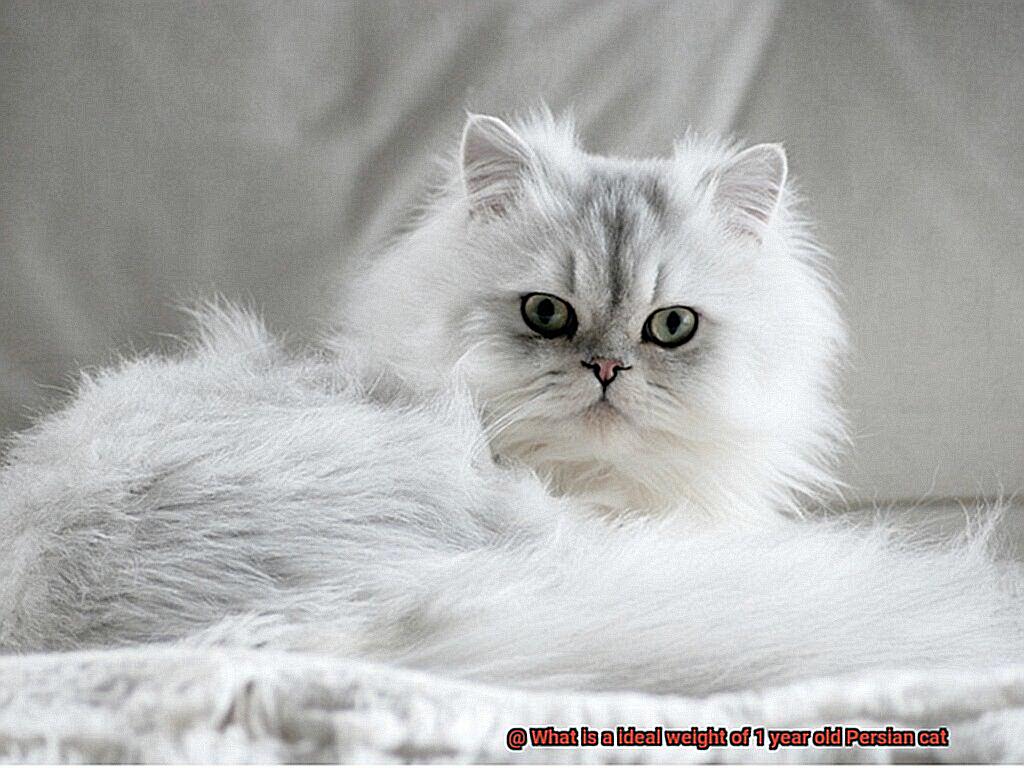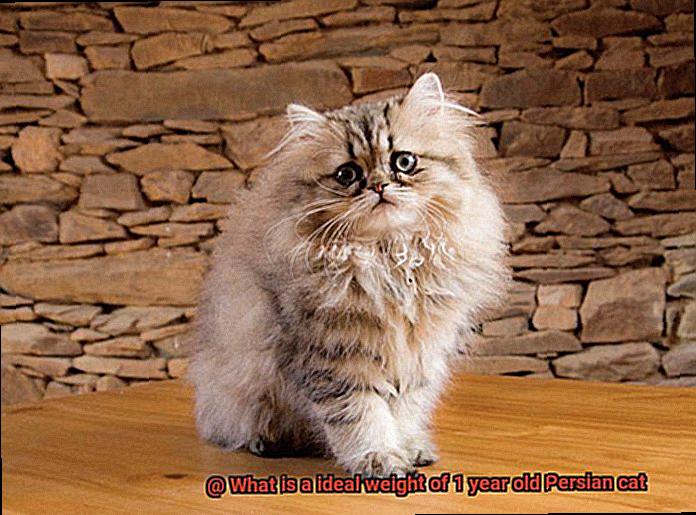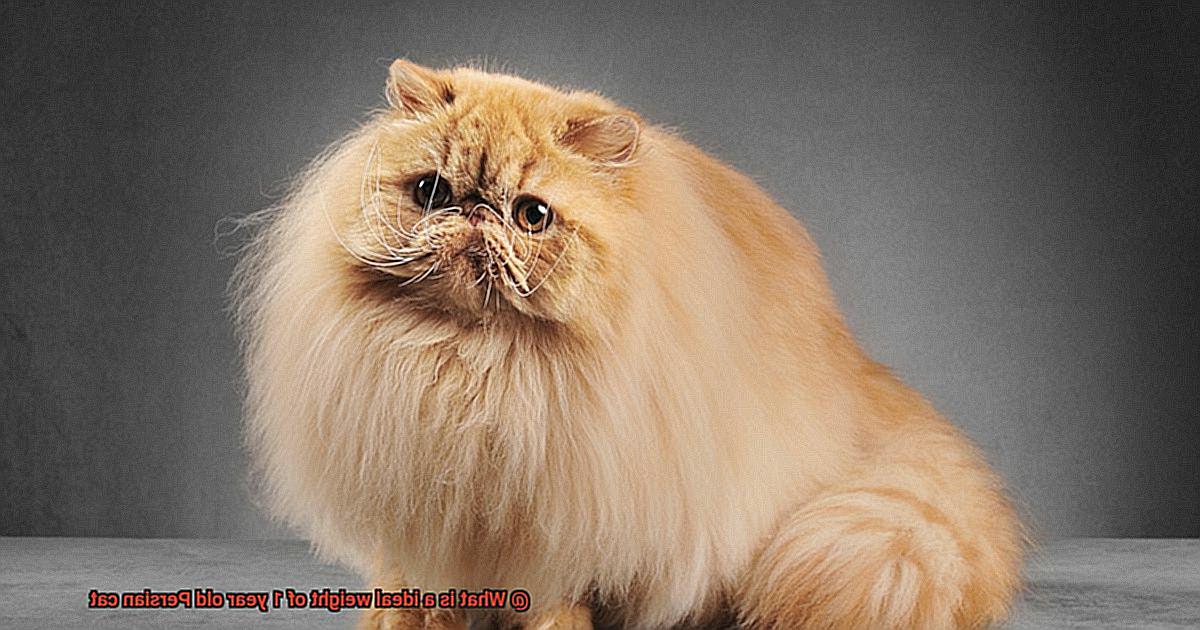As a cat parent, you know that each feline is unique and comes in various shapes and sizes. The Persian cat breed, with its long and luxurious coat and striking features like round faces and big eyes, is no exception. However, when it comes to your furry friend’s health, their weight plays a significant role.
If you’re a Persian cat parent of a one-year-old kitty, you might be curious about the ideal weight range for your pet. It’s a common question many owners ask to ensure their feline companion maintains a healthy weight.
In this blog post, we’ll explore the perfect weight range for 1-year-old Persian cats. We’ll also delve into factors that affect your cat’s weight like diet, lifestyle, and activity level. Furthermore, we’ll discuss how to gauge your cat’s weight and what to do if you have concerns about their weight.
So let’s jump right in and discover what an ideal weight range for 1-year-old Persian cats looks like.
Average Weight of 1-Year-Old Persian Cats
When it comes to 1-year-old Persian cats, there are a few factors to consider when determining what their ideal weight should be.
On average, a healthy 1-year-old Persian cat should weigh between 7 and 12 pounds. However, this range can vary depending on factors such as genetics, gender, and lifestyle. Females tend to weigh less, while males can be slightly heavier.

To ensure your Persian cat is at a healthy weight, it’s important to monitor their diet and exercise levels. Overfeeding or not providing enough exercise can lead to excess weight gain, which can cause serious health issues such as diabetes and heart disease. On the other hand, not providing enough food or feeding a poor quality diet can lead to malnourishment and underweight cats.
To determine if your Persian cat is at a healthy weight, you can do a simple body condition score (BCS) assessment. This involves feeling for your cat’s ribs and checking their overall shape. A healthy Persian cat should have a waistline that is visible from above and have ribs that are easily felt without being visible.
It’s important to check your cat’s weight regularly and make adjustments to their diet or exercise routine if necessary. By providing your Persian cat with a balanced diet and regular exercise, you can help them maintain a healthy weight and avoid health problems down the line.
If you’re unsure about what your cat’s ideal weight should be or if you have concerns about their weight, consult with your veterinarian for guidance. They may recommend specific dietary changes or exercise routines to ensure your Persian cat stays healthy and happy.

Factors that Affect the Ideal Weight of a 1-Year-Old Persian Cat

However, it can be puzzling to determine the ideal weight for your 1-year-old Persian cat. To unravel this mystery, let’s explore the various factors that influence their weight.

Firstly, genetics is a crucial factor in determining the ideal weight of a Persian cat. The breed standard establishes a range of weights for each age group. Nonetheless, some cats may deviate from this standard due to their genetics. For instance, cats with a larger bone structure may weigh more than cats with a smaller bone structure, even if they are of the same gender and age.
Secondly, gender is another aspect that affects the ideal weight of a Persian cat. Male Persian cats are typically larger than females and may have a higher ideal weight. Nevertheless, it’s essential to consider other factors such as activity level and overall health to determine the appropriate weight range.
Speaking of activity level, it plays a pivotal role in maintaining your cat’s ideal weight. Active cats tend to burn more calories and maintain a healthy weight. Conversely, sedentary cats may gain weight quickly and become overweight. Therefore, it’s essential to create an active environment for your cat by providing toys and space for playtime.
Lastly, overall health is critical in determining your cat’s ideal weight. Health issues such as diabetes, thyroid problems, and other metabolic disorders can cause weight gain or loss in cats. Regular monitoring of your cat’s weight and consulting with your veterinarian can help ensure that any health issues are promptly addressed.
Body Condition Score Assessment for Determining Ideal Weight
Luckily, veterinarians have a tool to determine the ideal weight for cats – the body condition score (BCS) assessment.
The BCS assessment evaluates a cat’s body composition, muscle tone, and overall body fat percentage. The scoring system ranges from 1 to 9, with 1 indicating severe emaciation, and 9 indicating severe obesity. The ideal score for most cats is 5.

To conduct a BCS assessment for your Persian cat, start by examining them from a distance. Look for an hourglass figure with a visible waistline and a gentle curve at the ribs. Your cat’s spine should be easy to feel but not visible, and its hips should not protrude.
Next, use your hands to feel for the cat’s ribs, spine, and hips. You should be able to feel the ribs without pressing too hard, but they should not be easily visible. The spine should be easy to feel but not prominent or sharp, and the hips should have some padding but not be overly round or protruding.
Maintaining an ideal weight is crucial for your cat’s overall health and well-being. Obesity can lead to numerous health problems such as diabetes, heart disease, and joint issues. By conducting a thorough BCS assessment, you can determine whether your one-year-old Persian cat is at its ideal weight or needs adjustments to their diet and exercise routine.
The Impact of Obesity on Cats
These cats are known for their stocky build, which can make them more prone to weight gain and its associated health problems.
Obesity in cats can lead to a myriad of health issues such as diabetes, heart disease, joint pain, and respiratory problems. It can also reduce their mobility and activity levels, leading to a shorter lifespan and decreased quality of life. Therefore, it is imperative that we take extra care to ensure our Persian cats maintain a healthy weight.
To help our furry friends stay in shape, we must start by monitoring their weight and body condition regularly. Your veterinarian can help you determine if your cat is at a healthy weight using a body condition score assessment. From there, you can work together to develop an appropriate diet and exercise plan for your cat.
To prevent overeating and weight gain, it’s crucial to avoid free-feeding your cat. Instead, provide appropriate portion sizes based on their individual needs. Incorporating regular exercise into your cat’s routine can also help keep them active and burn off excess calories.
It is worth noting that Persian cats are predisposed to obesity due to their unique body structure. Therefore, owners must be proactive in maintaining a healthy weight throughout their life. By doing so, they can prevent numerous health complications that may arise.
If your Persian cat does become overweight or obese, don’t panic. Working with your veterinarian, you can develop a safe and effective weight loss plan that includes gradual weight loss through increased exercise and a balanced diet. Rapid weight loss can be dangerous for cats and should be avoided.
Balanced Diet and Regular Exercise for Healthy Weight Maintenance

Maintaining a healthy weight for your beloved Persian cat is crucial for their overall well-being. A well-proportioned body with a visible waistline when viewed from above is the hallmark of a healthy Persian cat. To achieve and maintain this, providing them with a balanced diet and regular exercise is essential.
Firstly, let’s talk about the balanced diet that your Persian cat requires. High-quality protein, moderate fat, and low carbohydrates should be the foundation of their diet. It is important to choose food that is specifically formulated for cats and avoid giving them table scraps or human food. Overfeeding your cat can lead to obesity, which can lead to a variety of health issues such as diabetes, heart disease, and joint problems.
In addition to providing a balanced diet, regular exercise is just as important. Cats are naturally active animals and need physical and mental stimulation. You can provide them with toys or climbing structures that encourage them to move around and play. Interactive playtime with your cat is also an excellent way to keep them active and engaged.
It’s important to note that every Persian cat has unique needs, and the ideal weight for a 1-year-old Persian cat may vary depending on their gender, genetics, and lifestyle. Therefore, it is recommended to consult with your veterinarian to determine the appropriate weight range for your specific cat. They can also provide you with guidance on feeding schedules, portion sizes, and exercise routines tailored to your cat’s needs.
Tips to Monitor Your Cat’s Weight
Keeping your Persian cat at a healthy weight is crucial to their overall well-being. Here are five tips to help you monitor your cat’s weight and ensure they are at a healthy weight:
Regular weigh-ins
Weighing your cat regularly is an effective way to monitor their weight. Use a digital scale or weigh yourself first and then pick up your cat and weigh yourself again. Record their weight in a notebook or spreadsheet to track any changes.
Body condition scoring
Assess your cat’s body condition by feeling their ribs and spine for signs of fat or muscle loss. A healthy Persian cat should have a visible waistline from above and easily felt ribs.
Monitor food intake
Keep an eye on how much food your cat is eating and adjust their portion sizes accordingly. Avoid free-feeding and stick to set meal times. Ensure you feed them a high-quality, balanced diet that matches their age and activity level.
Provide regular exercise
Encourage your cat to engage in physical activity to help them maintain a healthy weight. Toys, play sessions, walks on a leash, and obstacle courses are all great ways to keep them active.
Consult with a veterinarian
If you’re unsure about your cat’s weight, consult with a veterinarian for guidance on proper nutrition and weight management. They can also help you develop a weight loss plan if necessary.
Warning Signs of Unhealthy Weight in Cats
One of the most crucial aspects of their well-being is maintaining a healthy weight. An overweight cat can lead to various health issues like diabetes, arthritis, and heart disease, while an underweight cat may suffer from malnutrition and underlying health problems.
So, what are the warning signs of unhealthy weight in cats? Here are some telltale signs to watch out for:
Physical Signs:
- Unable to feel ribs or spine: When you pet your cat, you should be able to feel their ribs and spine. If you can’t, it could be a sign that your cat is carrying excess weight.
- Saggy belly or fat deposits: If your cat has a saggy belly or fat deposits around their hips or back legs, this could also indicate that they are carrying too much weight.
Behavioral Signs:
- Decreased activity levels: If your cat has become less active and spends most of their time sleeping or lounging around, this could be a sign of excess weight.
- Increased appetite: If your cat suddenly increases their appetite or begs for food constantly, this could be a sign that they are not getting enough nutrition from their meals.
_dFdyUuB440″ >
Conclusion
In summary, maintaining a healthy weight for your 1-year-old Persian cat is paramount for their overall health and well-being. While the ideal weight range falls between 7 and 12 pounds, this can vary based on genetics, gender, and lifestyle factors. Overfeeding or lack of exercise can lead to excess weight gain, while insufficient food or poor-quality diets can result in malnourishment and underweight cats.
To ensure your Persian cat remains at a healthy weight, it’s crucial to monitor their diet and exercise levels regularly. You can conduct a simple body condition score (BCS) assessment to determine if your cat has a visible waistline from above and easily felt ribs without being visible. Additionally, consulting with your veterinarian is essential if you have any concerns about your cat’s weight.
Maintaining an ideal weight for your Persian cat requires a balanced diet that includes high-quality protein, moderate fat, and low carbohydrates. Along with regular exercise such as playtime with toys or climbing structures that encourage movement. Every Persian cat has unique needs; therefore, it is recommended to consult with your veterinarian to determine the appropriate weight range for your specific cat.
Lastly, warning signs of unhealthy weight in cats include physical signs like saggy belly or fat deposits around hips or back legs and behavioral signs like decreased activity levels or increased appetite. By following these tips and monitoring your cat’s weight regularly, you can help them maintain good health and avoid serious health complications down the line.

